Strategic Analysis of Grab Company: PESTLE and Porter's Five Forces
VerifiedAdded on 2021/06/15
|12
|3045
|44
Report
AI Summary
This report offers a comprehensive analysis of Grab Company, a Singapore-based technology company specializing in ride-hailing and related services. The analysis begins with a PESTLE analysis, examining the political, economic, social, technological, legal, and environmental factors influencing Grab's operations. The report then delves into Porter's Five Forces, assessing competitive rivalry, the power of suppliers and buyers, the threat of substitution, and the threat of new entrants within the market. Each factor is evaluated in the context of Grab's business environment. The report concludes with strategic recommendations, including market expansion, mergers and acquisitions, organizational restructuring, and the introduction of new products and services, all aimed at enhancing Grab's profitability and market position. These strategies are designed to help Grab navigate the competitive landscape, capitalize on market opportunities, and achieve sustainable growth. The analysis underscores the importance of adapting to changing market conditions and leveraging strategic initiatives to maintain a competitive edge.
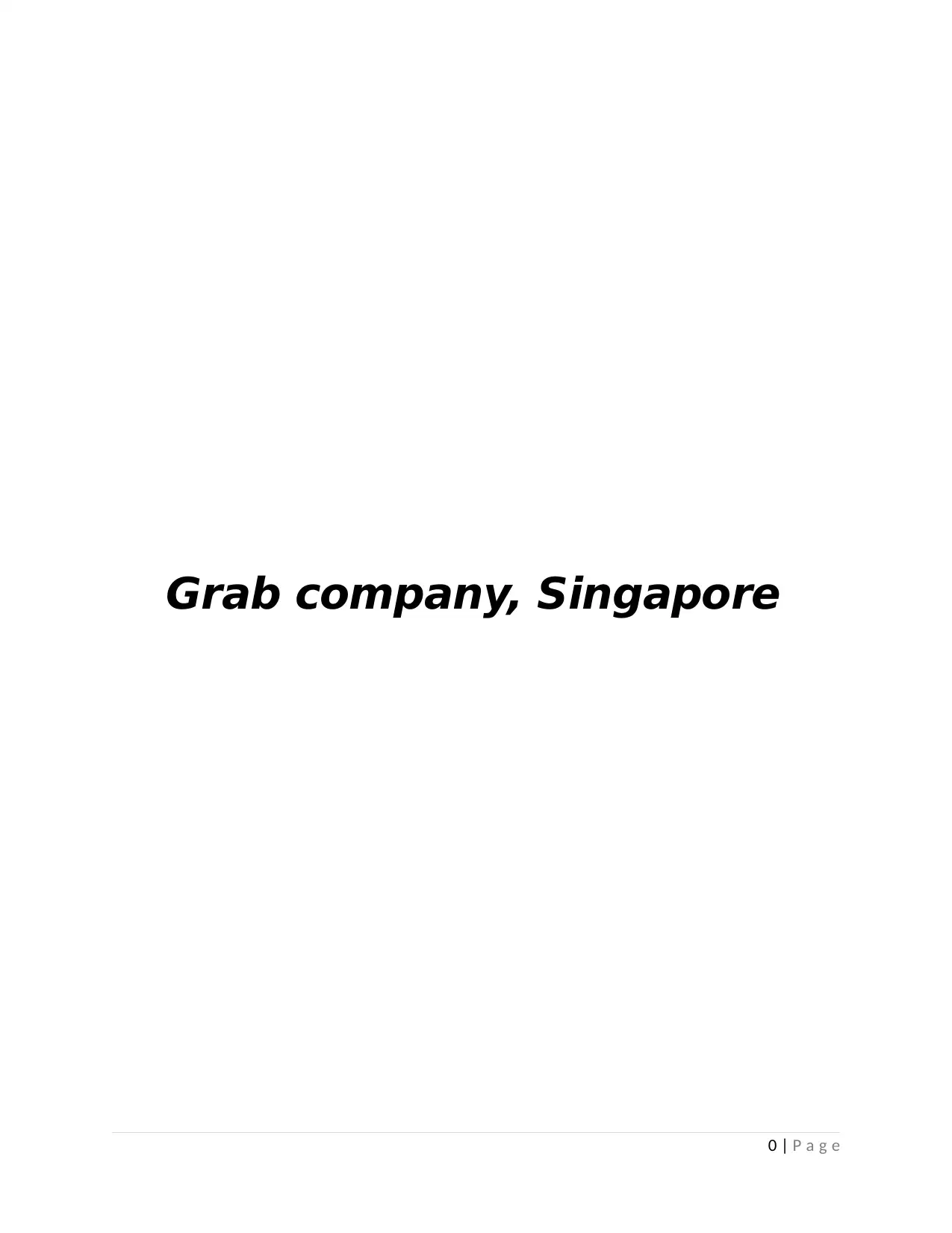
Grab company, Singapore
0 | P a g e
0 | P a g e
Paraphrase This Document
Need a fresh take? Get an instant paraphrase of this document with our AI Paraphraser
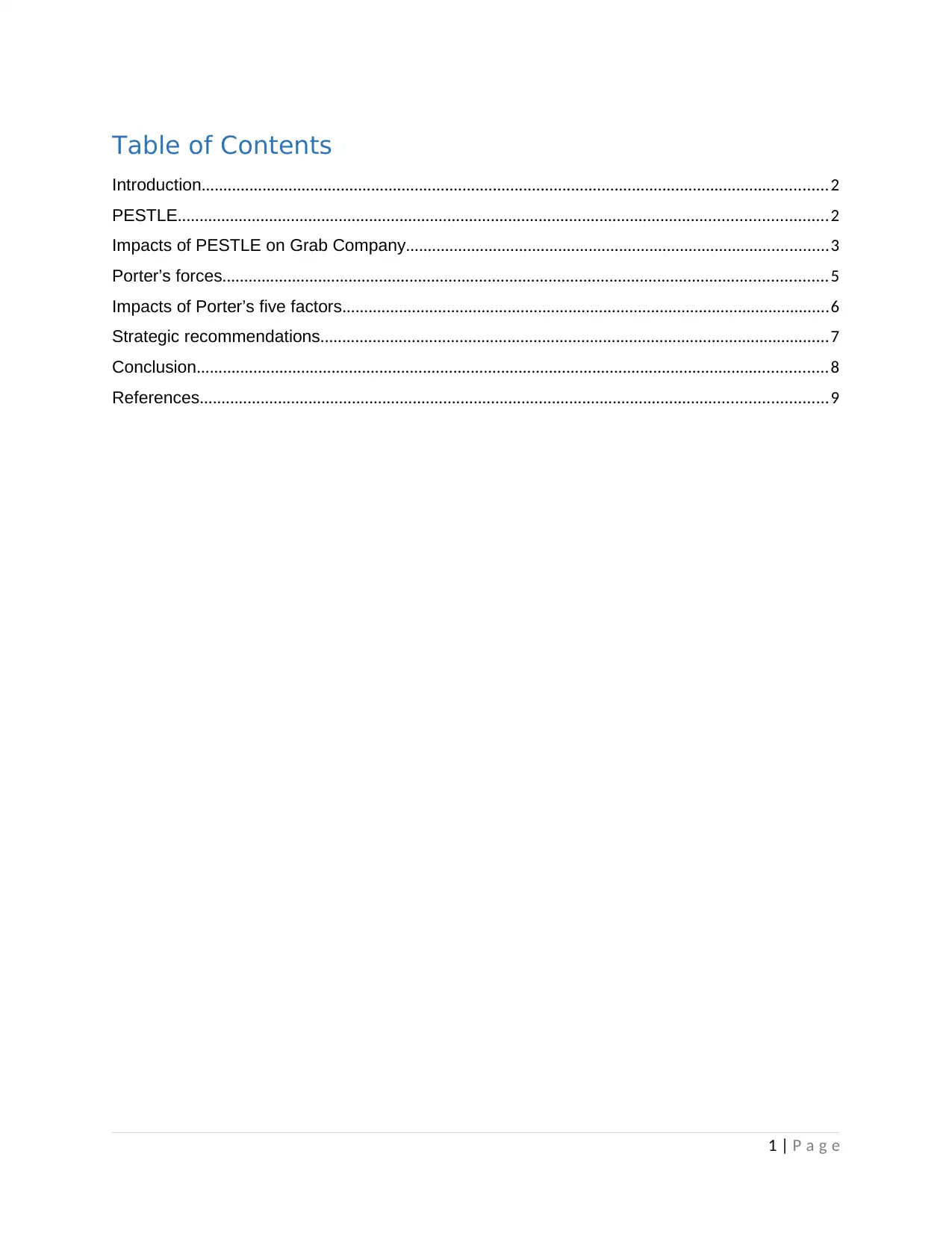
Table of Contents
Introduction................................................................................................................................................2
PESTLE.....................................................................................................................................................2
Impacts of PESTLE on Grab Company.................................................................................................3
Porter’s forces...........................................................................................................................................5
Impacts of Porter’s five factors................................................................................................................6
Strategic recommendations.....................................................................................................................7
Conclusion.................................................................................................................................................8
References................................................................................................................................................9
1 | P a g e
Introduction................................................................................................................................................2
PESTLE.....................................................................................................................................................2
Impacts of PESTLE on Grab Company.................................................................................................3
Porter’s forces...........................................................................................................................................5
Impacts of Porter’s five factors................................................................................................................6
Strategic recommendations.....................................................................................................................7
Conclusion.................................................................................................................................................8
References................................................................................................................................................9
1 | P a g e
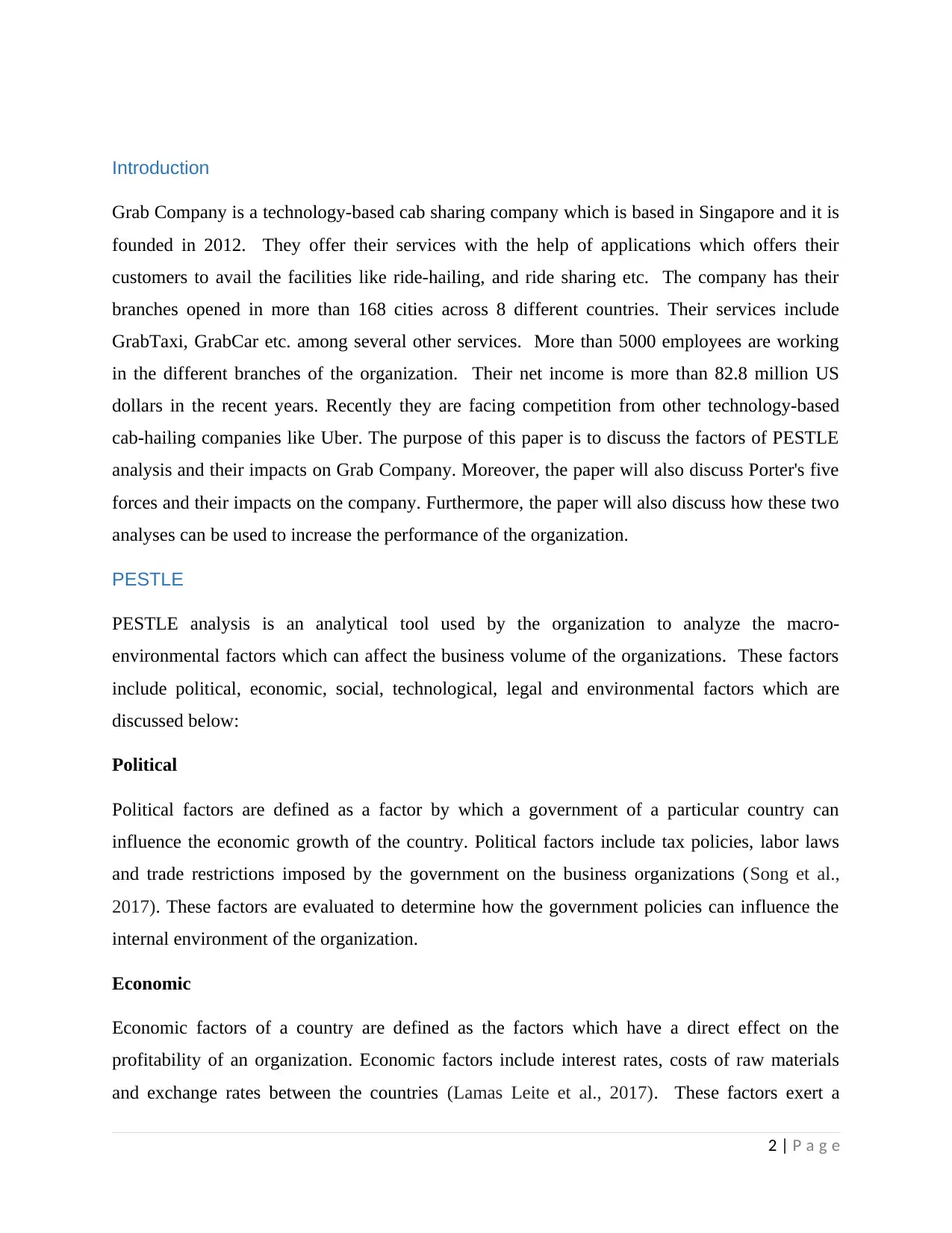
Introduction
Grab Company is a technology-based cab sharing company which is based in Singapore and it is
founded in 2012. They offer their services with the help of applications which offers their
customers to avail the facilities like ride-hailing, and ride sharing etc. The company has their
branches opened in more than 168 cities across 8 different countries. Their services include
GrabTaxi, GrabCar etc. among several other services. More than 5000 employees are working
in the different branches of the organization. Their net income is more than 82.8 million US
dollars in the recent years. Recently they are facing competition from other technology-based
cab-hailing companies like Uber. The purpose of this paper is to discuss the factors of PESTLE
analysis and their impacts on Grab Company. Moreover, the paper will also discuss Porter's five
forces and their impacts on the company. Furthermore, the paper will also discuss how these two
analyses can be used to increase the performance of the organization.
PESTLE
PESTLE analysis is an analytical tool used by the organization to analyze the macro-
environmental factors which can affect the business volume of the organizations. These factors
include political, economic, social, technological, legal and environmental factors which are
discussed below:
Political
Political factors are defined as a factor by which a government of a particular country can
influence the economic growth of the country. Political factors include tax policies, labor laws
and trade restrictions imposed by the government on the business organizations (Song et al.,
2017). These factors are evaluated to determine how the government policies can influence the
internal environment of the organization.
Economic
Economic factors of a country are defined as the factors which have a direct effect on the
profitability of an organization. Economic factors include interest rates, costs of raw materials
and exchange rates between the countries (Lamas Leite et al., 2017). These factors exert a
2 | P a g e
Grab Company is a technology-based cab sharing company which is based in Singapore and it is
founded in 2012. They offer their services with the help of applications which offers their
customers to avail the facilities like ride-hailing, and ride sharing etc. The company has their
branches opened in more than 168 cities across 8 different countries. Their services include
GrabTaxi, GrabCar etc. among several other services. More than 5000 employees are working
in the different branches of the organization. Their net income is more than 82.8 million US
dollars in the recent years. Recently they are facing competition from other technology-based
cab-hailing companies like Uber. The purpose of this paper is to discuss the factors of PESTLE
analysis and their impacts on Grab Company. Moreover, the paper will also discuss Porter's five
forces and their impacts on the company. Furthermore, the paper will also discuss how these two
analyses can be used to increase the performance of the organization.
PESTLE
PESTLE analysis is an analytical tool used by the organization to analyze the macro-
environmental factors which can affect the business volume of the organizations. These factors
include political, economic, social, technological, legal and environmental factors which are
discussed below:
Political
Political factors are defined as a factor by which a government of a particular country can
influence the economic growth of the country. Political factors include tax policies, labor laws
and trade restrictions imposed by the government on the business organizations (Song et al.,
2017). These factors are evaluated to determine how the government policies can influence the
internal environment of the organization.
Economic
Economic factors of a country are defined as the factors which have a direct effect on the
profitability of an organization. Economic factors include interest rates, costs of raw materials
and exchange rates between the countries (Lamas Leite et al., 2017). These factors exert a
2 | P a g e
⊘ This is a preview!⊘
Do you want full access?
Subscribe today to unlock all pages.

Trusted by 1+ million students worldwide
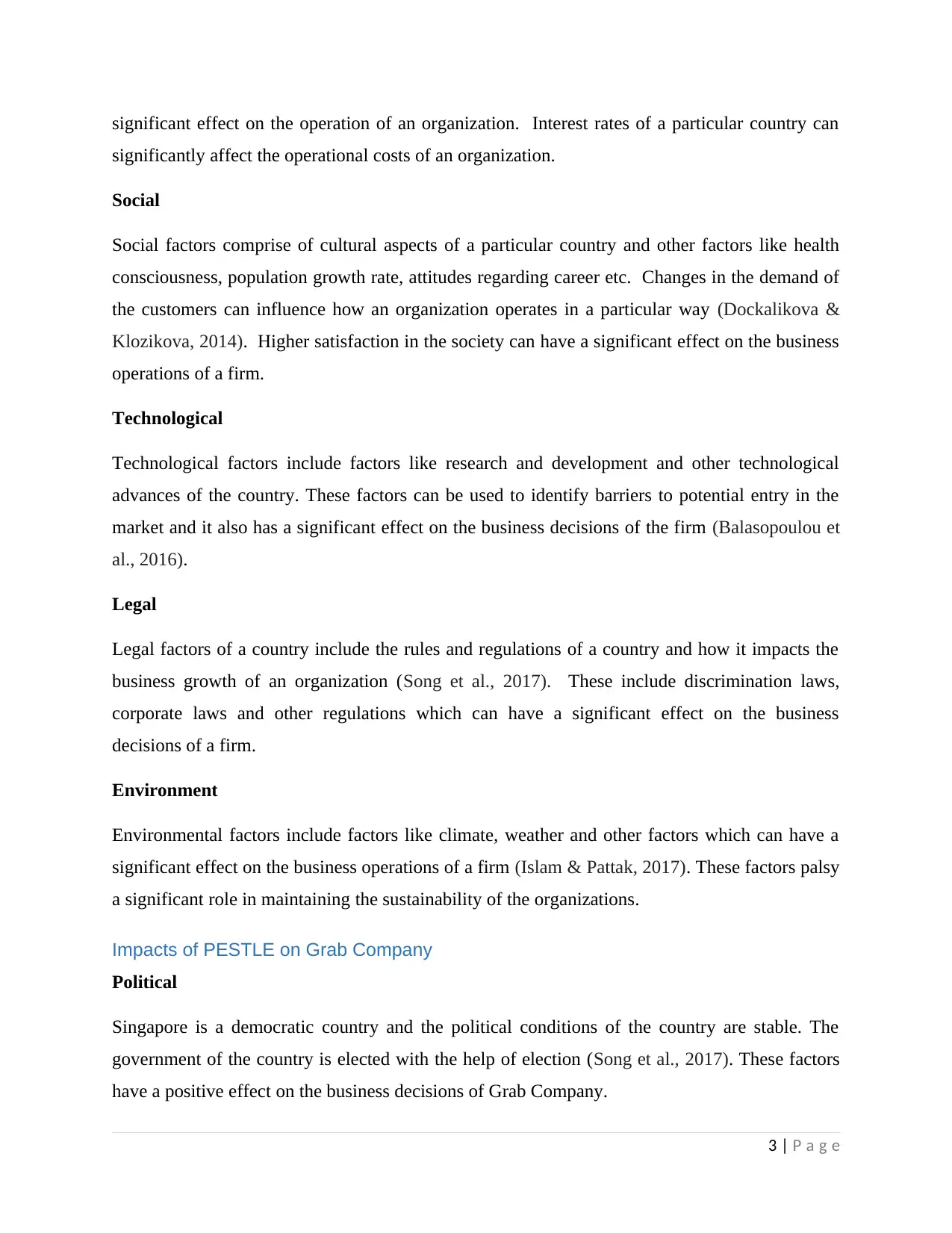
significant effect on the operation of an organization. Interest rates of a particular country can
significantly affect the operational costs of an organization.
Social
Social factors comprise of cultural aspects of a particular country and other factors like health
consciousness, population growth rate, attitudes regarding career etc. Changes in the demand of
the customers can influence how an organization operates in a particular way (Dockalikova &
Klozikova, 2014). Higher satisfaction in the society can have a significant effect on the business
operations of a firm.
Technological
Technological factors include factors like research and development and other technological
advances of the country. These factors can be used to identify barriers to potential entry in the
market and it also has a significant effect on the business decisions of the firm (Balasopoulou et
al., 2016).
Legal
Legal factors of a country include the rules and regulations of a country and how it impacts the
business growth of an organization (Song et al., 2017). These include discrimination laws,
corporate laws and other regulations which can have a significant effect on the business
decisions of a firm.
Environment
Environmental factors include factors like climate, weather and other factors which can have a
significant effect on the business operations of a firm (Islam & Pattak, 2017). These factors palsy
a significant role in maintaining the sustainability of the organizations.
Impacts of PESTLE on Grab Company
Political
Singapore is a democratic country and the political conditions of the country are stable. The
government of the country is elected with the help of election (Song et al., 2017). These factors
have a positive effect on the business decisions of Grab Company.
3 | P a g e
significantly affect the operational costs of an organization.
Social
Social factors comprise of cultural aspects of a particular country and other factors like health
consciousness, population growth rate, attitudes regarding career etc. Changes in the demand of
the customers can influence how an organization operates in a particular way (Dockalikova &
Klozikova, 2014). Higher satisfaction in the society can have a significant effect on the business
operations of a firm.
Technological
Technological factors include factors like research and development and other technological
advances of the country. These factors can be used to identify barriers to potential entry in the
market and it also has a significant effect on the business decisions of the firm (Balasopoulou et
al., 2016).
Legal
Legal factors of a country include the rules and regulations of a country and how it impacts the
business growth of an organization (Song et al., 2017). These include discrimination laws,
corporate laws and other regulations which can have a significant effect on the business
decisions of a firm.
Environment
Environmental factors include factors like climate, weather and other factors which can have a
significant effect on the business operations of a firm (Islam & Pattak, 2017). These factors palsy
a significant role in maintaining the sustainability of the organizations.
Impacts of PESTLE on Grab Company
Political
Singapore is a democratic country and the political conditions of the country are stable. The
government of the country is elected with the help of election (Song et al., 2017). These factors
have a positive effect on the business decisions of Grab Company.
3 | P a g e
Paraphrase This Document
Need a fresh take? Get an instant paraphrase of this document with our AI Paraphraser
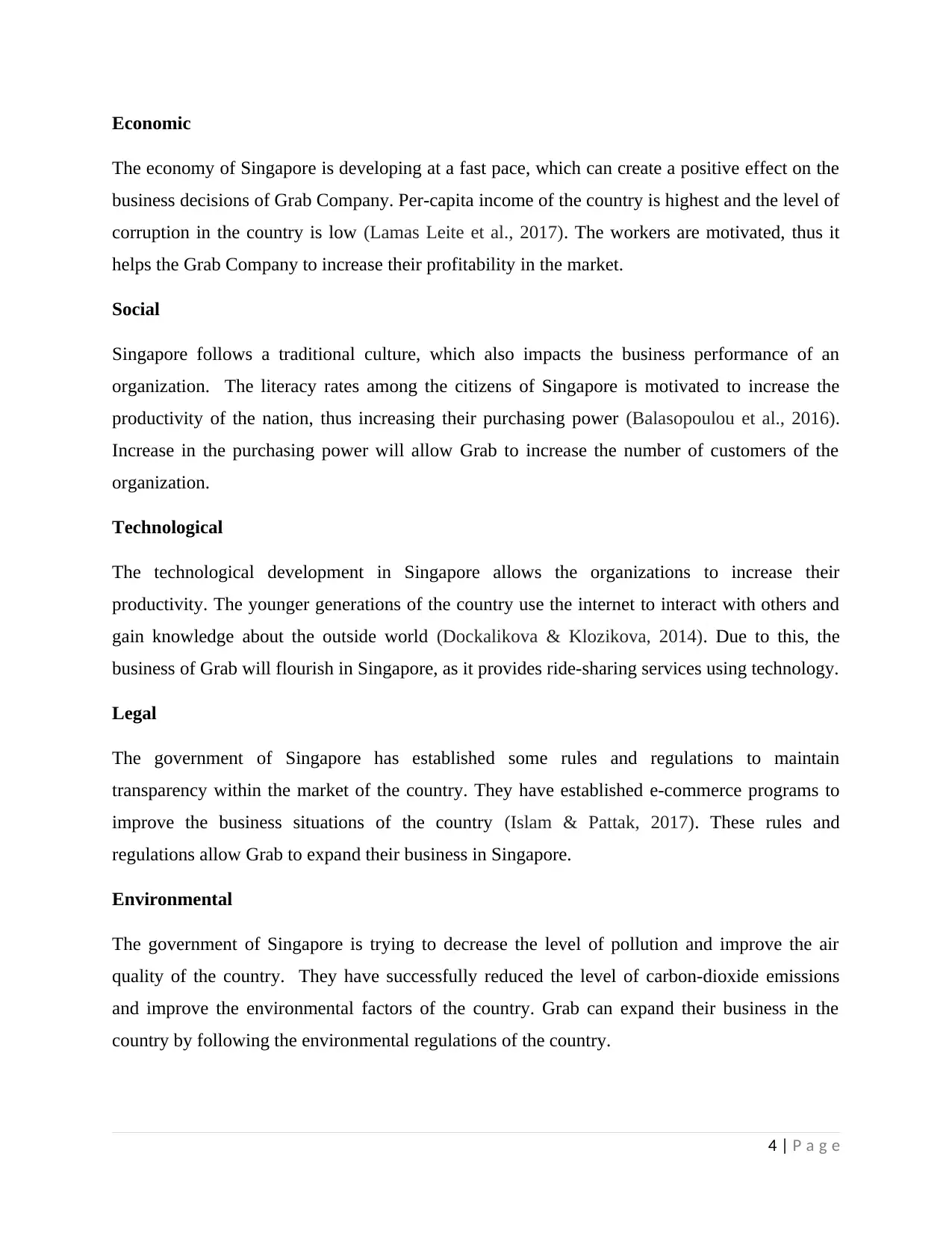
Economic
The economy of Singapore is developing at a fast pace, which can create a positive effect on the
business decisions of Grab Company. Per-capita income of the country is highest and the level of
corruption in the country is low (Lamas Leite et al., 2017). The workers are motivated, thus it
helps the Grab Company to increase their profitability in the market.
Social
Singapore follows a traditional culture, which also impacts the business performance of an
organization. The literacy rates among the citizens of Singapore is motivated to increase the
productivity of the nation, thus increasing their purchasing power (Balasopoulou et al., 2016).
Increase in the purchasing power will allow Grab to increase the number of customers of the
organization.
Technological
The technological development in Singapore allows the organizations to increase their
productivity. The younger generations of the country use the internet to interact with others and
gain knowledge about the outside world (Dockalikova & Klozikova, 2014). Due to this, the
business of Grab will flourish in Singapore, as it provides ride-sharing services using technology.
Legal
The government of Singapore has established some rules and regulations to maintain
transparency within the market of the country. They have established e-commerce programs to
improve the business situations of the country (Islam & Pattak, 2017). These rules and
regulations allow Grab to expand their business in Singapore.
Environmental
The government of Singapore is trying to decrease the level of pollution and improve the air
quality of the country. They have successfully reduced the level of carbon-dioxide emissions
and improve the environmental factors of the country. Grab can expand their business in the
country by following the environmental regulations of the country.
4 | P a g e
The economy of Singapore is developing at a fast pace, which can create a positive effect on the
business decisions of Grab Company. Per-capita income of the country is highest and the level of
corruption in the country is low (Lamas Leite et al., 2017). The workers are motivated, thus it
helps the Grab Company to increase their profitability in the market.
Social
Singapore follows a traditional culture, which also impacts the business performance of an
organization. The literacy rates among the citizens of Singapore is motivated to increase the
productivity of the nation, thus increasing their purchasing power (Balasopoulou et al., 2016).
Increase in the purchasing power will allow Grab to increase the number of customers of the
organization.
Technological
The technological development in Singapore allows the organizations to increase their
productivity. The younger generations of the country use the internet to interact with others and
gain knowledge about the outside world (Dockalikova & Klozikova, 2014). Due to this, the
business of Grab will flourish in Singapore, as it provides ride-sharing services using technology.
Legal
The government of Singapore has established some rules and regulations to maintain
transparency within the market of the country. They have established e-commerce programs to
improve the business situations of the country (Islam & Pattak, 2017). These rules and
regulations allow Grab to expand their business in Singapore.
Environmental
The government of Singapore is trying to decrease the level of pollution and improve the air
quality of the country. They have successfully reduced the level of carbon-dioxide emissions
and improve the environmental factors of the country. Grab can expand their business in the
country by following the environmental regulations of the country.
4 | P a g e
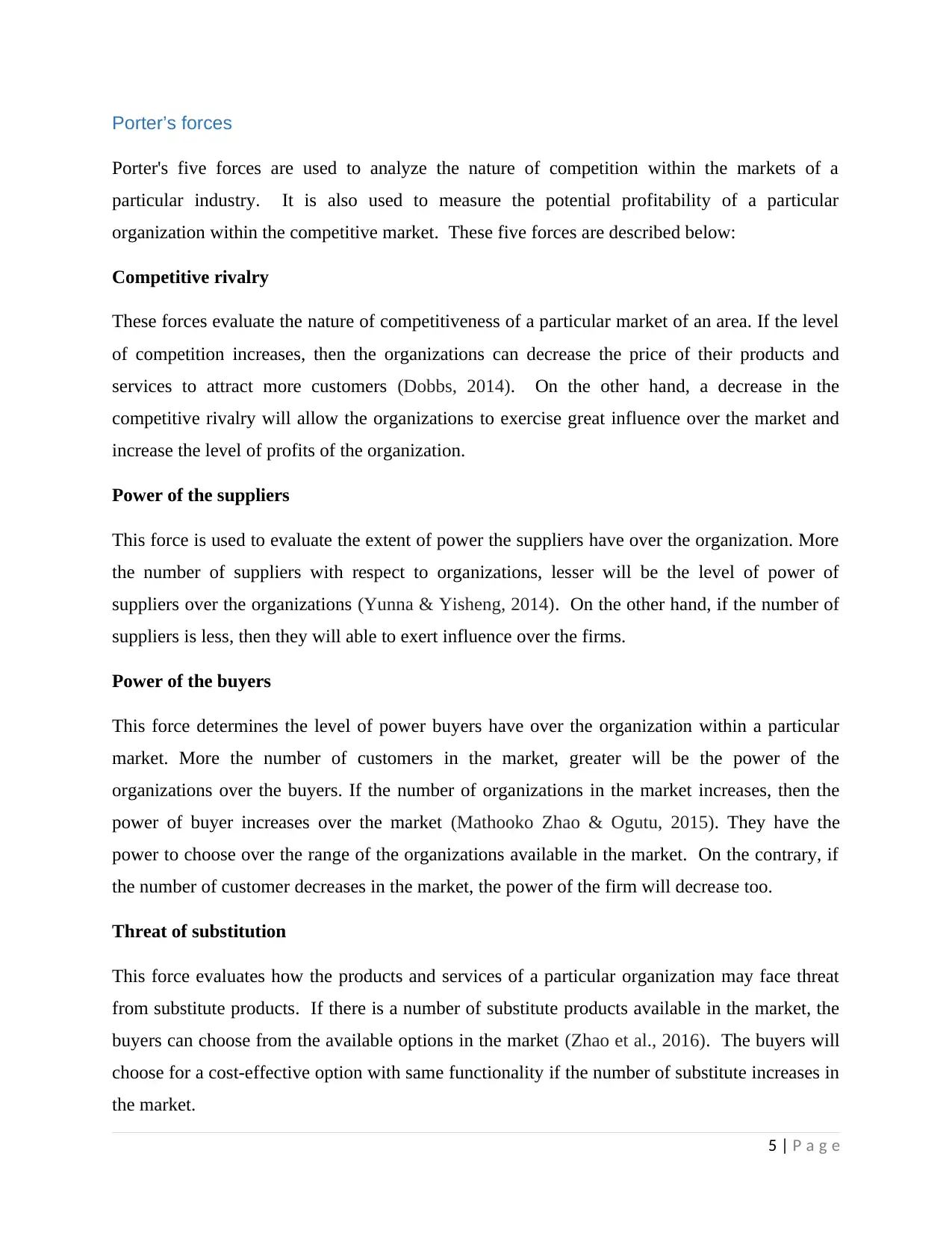
Porter’s forces
Porter's five forces are used to analyze the nature of competition within the markets of a
particular industry. It is also used to measure the potential profitability of a particular
organization within the competitive market. These five forces are described below:
Competitive rivalry
These forces evaluate the nature of competitiveness of a particular market of an area. If the level
of competition increases, then the organizations can decrease the price of their products and
services to attract more customers (Dobbs, 2014). On the other hand, a decrease in the
competitive rivalry will allow the organizations to exercise great influence over the market and
increase the level of profits of the organization.
Power of the suppliers
This force is used to evaluate the extent of power the suppliers have over the organization. More
the number of suppliers with respect to organizations, lesser will be the level of power of
suppliers over the organizations (Yunna & Yisheng, 2014). On the other hand, if the number of
suppliers is less, then they will able to exert influence over the firms.
Power of the buyers
This force determines the level of power buyers have over the organization within a particular
market. More the number of customers in the market, greater will be the power of the
organizations over the buyers. If the number of organizations in the market increases, then the
power of buyer increases over the market (Mathooko Zhao & Ogutu, 2015). They have the
power to choose over the range of the organizations available in the market. On the contrary, if
the number of customer decreases in the market, the power of the firm will decrease too.
Threat of substitution
This force evaluates how the products and services of a particular organization may face threat
from substitute products. If there is a number of substitute products available in the market, the
buyers can choose from the available options in the market (Zhao et al., 2016). The buyers will
choose for a cost-effective option with same functionality if the number of substitute increases in
the market.
5 | P a g e
Porter's five forces are used to analyze the nature of competition within the markets of a
particular industry. It is also used to measure the potential profitability of a particular
organization within the competitive market. These five forces are described below:
Competitive rivalry
These forces evaluate the nature of competitiveness of a particular market of an area. If the level
of competition increases, then the organizations can decrease the price of their products and
services to attract more customers (Dobbs, 2014). On the other hand, a decrease in the
competitive rivalry will allow the organizations to exercise great influence over the market and
increase the level of profits of the organization.
Power of the suppliers
This force is used to evaluate the extent of power the suppliers have over the organization. More
the number of suppliers with respect to organizations, lesser will be the level of power of
suppliers over the organizations (Yunna & Yisheng, 2014). On the other hand, if the number of
suppliers is less, then they will able to exert influence over the firms.
Power of the buyers
This force determines the level of power buyers have over the organization within a particular
market. More the number of customers in the market, greater will be the power of the
organizations over the buyers. If the number of organizations in the market increases, then the
power of buyer increases over the market (Mathooko Zhao & Ogutu, 2015). They have the
power to choose over the range of the organizations available in the market. On the contrary, if
the number of customer decreases in the market, the power of the firm will decrease too.
Threat of substitution
This force evaluates how the products and services of a particular organization may face threat
from substitute products. If there is a number of substitute products available in the market, the
buyers can choose from the available options in the market (Zhao et al., 2016). The buyers will
choose for a cost-effective option with same functionality if the number of substitute increases in
the market.
5 | P a g e
⊘ This is a preview!⊘
Do you want full access?
Subscribe today to unlock all pages.

Trusted by 1+ million students worldwide
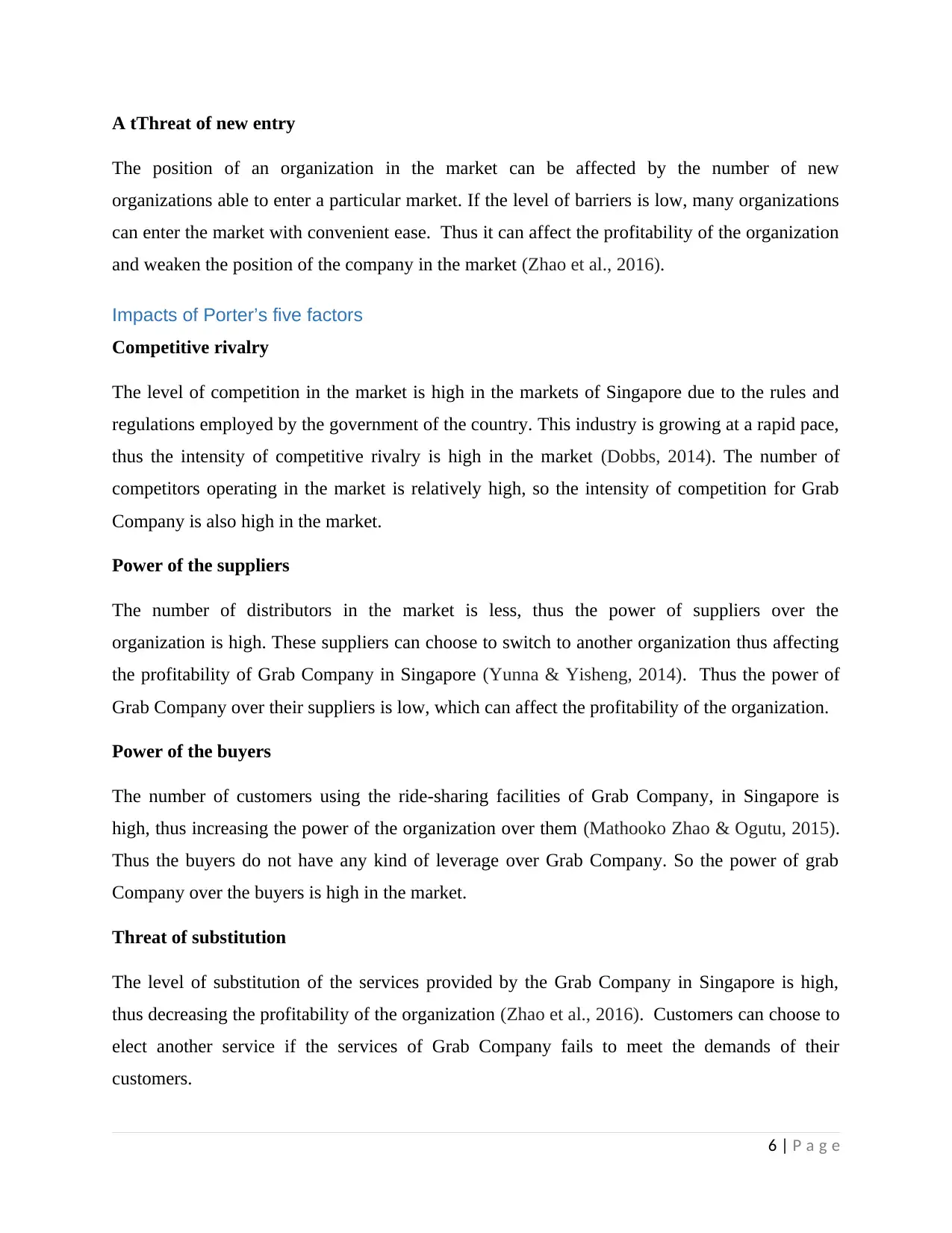
A tThreat of new entry
The position of an organization in the market can be affected by the number of new
organizations able to enter a particular market. If the level of barriers is low, many organizations
can enter the market with convenient ease. Thus it can affect the profitability of the organization
and weaken the position of the company in the market (Zhao et al., 2016).
Impacts of Porter’s five factors
Competitive rivalry
The level of competition in the market is high in the markets of Singapore due to the rules and
regulations employed by the government of the country. This industry is growing at a rapid pace,
thus the intensity of competitive rivalry is high in the market (Dobbs, 2014). The number of
competitors operating in the market is relatively high, so the intensity of competition for Grab
Company is also high in the market.
Power of the suppliers
The number of distributors in the market is less, thus the power of suppliers over the
organization is high. These suppliers can choose to switch to another organization thus affecting
the profitability of Grab Company in Singapore (Yunna & Yisheng, 2014). Thus the power of
Grab Company over their suppliers is low, which can affect the profitability of the organization.
Power of the buyers
The number of customers using the ride-sharing facilities of Grab Company, in Singapore is
high, thus increasing the power of the organization over them (Mathooko Zhao & Ogutu, 2015).
Thus the buyers do not have any kind of leverage over Grab Company. So the power of grab
Company over the buyers is high in the market.
Threat of substitution
The level of substitution of the services provided by the Grab Company in Singapore is high,
thus decreasing the profitability of the organization (Zhao et al., 2016). Customers can choose to
elect another service if the services of Grab Company fails to meet the demands of their
customers.
6 | P a g e
The position of an organization in the market can be affected by the number of new
organizations able to enter a particular market. If the level of barriers is low, many organizations
can enter the market with convenient ease. Thus it can affect the profitability of the organization
and weaken the position of the company in the market (Zhao et al., 2016).
Impacts of Porter’s five factors
Competitive rivalry
The level of competition in the market is high in the markets of Singapore due to the rules and
regulations employed by the government of the country. This industry is growing at a rapid pace,
thus the intensity of competitive rivalry is high in the market (Dobbs, 2014). The number of
competitors operating in the market is relatively high, so the intensity of competition for Grab
Company is also high in the market.
Power of the suppliers
The number of distributors in the market is less, thus the power of suppliers over the
organization is high. These suppliers can choose to switch to another organization thus affecting
the profitability of Grab Company in Singapore (Yunna & Yisheng, 2014). Thus the power of
Grab Company over their suppliers is low, which can affect the profitability of the organization.
Power of the buyers
The number of customers using the ride-sharing facilities of Grab Company, in Singapore is
high, thus increasing the power of the organization over them (Mathooko Zhao & Ogutu, 2015).
Thus the buyers do not have any kind of leverage over Grab Company. So the power of grab
Company over the buyers is high in the market.
Threat of substitution
The level of substitution of the services provided by the Grab Company in Singapore is high,
thus decreasing the profitability of the organization (Zhao et al., 2016). Customers can choose to
elect another service if the services of Grab Company fails to meet the demands of their
customers.
6 | P a g e
Paraphrase This Document
Need a fresh take? Get an instant paraphrase of this document with our AI Paraphraser

7 | P a g e
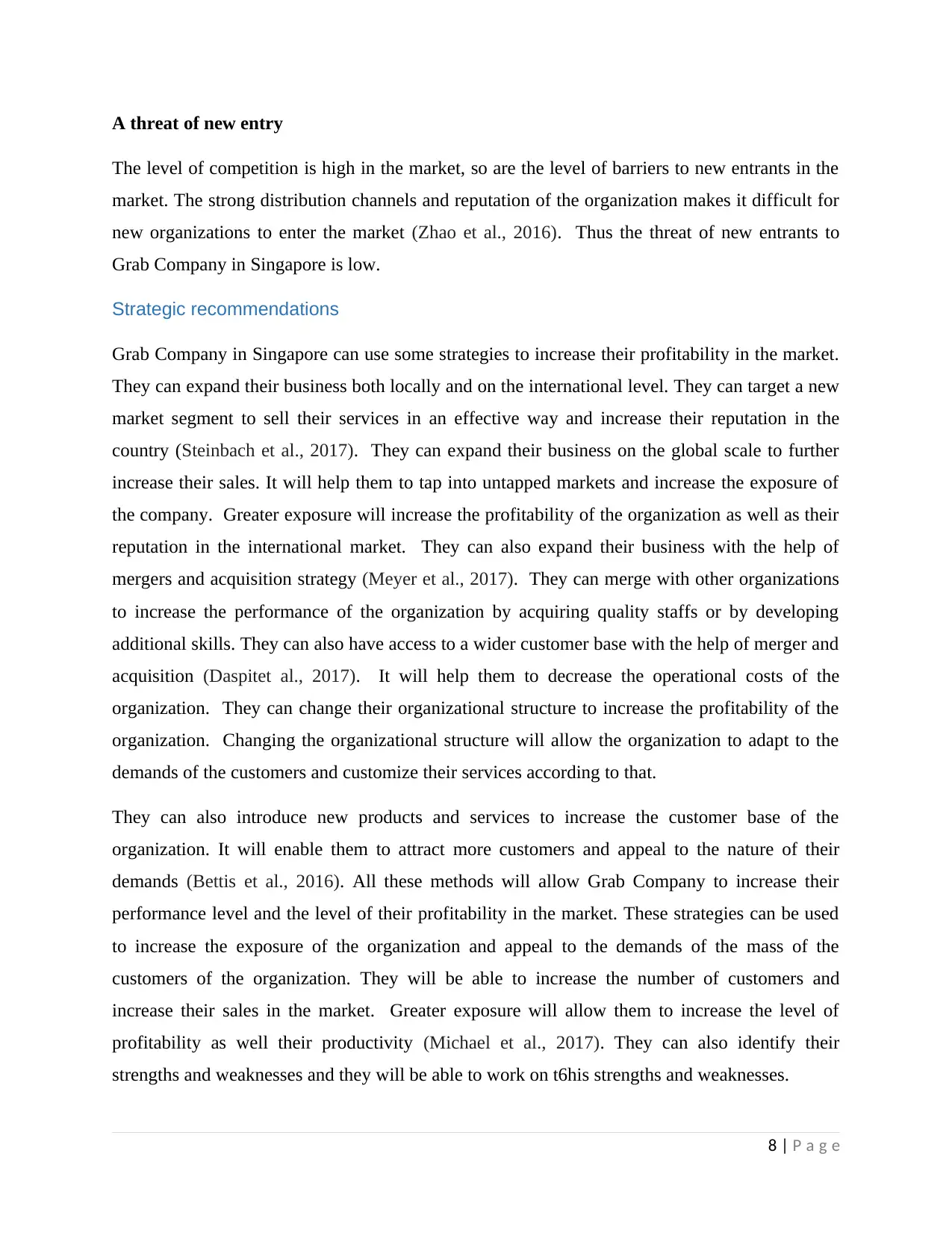
A threat of new entry
The level of competition is high in the market, so are the level of barriers to new entrants in the
market. The strong distribution channels and reputation of the organization makes it difficult for
new organizations to enter the market (Zhao et al., 2016). Thus the threat of new entrants to
Grab Company in Singapore is low.
Strategic recommendations
Grab Company in Singapore can use some strategies to increase their profitability in the market.
They can expand their business both locally and on the international level. They can target a new
market segment to sell their services in an effective way and increase their reputation in the
country (Steinbach et al., 2017). They can expand their business on the global scale to further
increase their sales. It will help them to tap into untapped markets and increase the exposure of
the company. Greater exposure will increase the profitability of the organization as well as their
reputation in the international market. They can also expand their business with the help of
mergers and acquisition strategy (Meyer et al., 2017). They can merge with other organizations
to increase the performance of the organization by acquiring quality staffs or by developing
additional skills. They can also have access to a wider customer base with the help of merger and
acquisition (Daspitet al., 2017). It will help them to decrease the operational costs of the
organization. They can change their organizational structure to increase the profitability of the
organization. Changing the organizational structure will allow the organization to adapt to the
demands of the customers and customize their services according to that.
They can also introduce new products and services to increase the customer base of the
organization. It will enable them to attract more customers and appeal to the nature of their
demands (Bettis et al., 2016). All these methods will allow Grab Company to increase their
performance level and the level of their profitability in the market. These strategies can be used
to increase the exposure of the organization and appeal to the demands of the mass of the
customers of the organization. They will be able to increase the number of customers and
increase their sales in the market. Greater exposure will allow them to increase the level of
profitability as well their productivity (Michael et al., 2017). They can also identify their
strengths and weaknesses and they will be able to work on t6his strengths and weaknesses.
8 | P a g e
The level of competition is high in the market, so are the level of barriers to new entrants in the
market. The strong distribution channels and reputation of the organization makes it difficult for
new organizations to enter the market (Zhao et al., 2016). Thus the threat of new entrants to
Grab Company in Singapore is low.
Strategic recommendations
Grab Company in Singapore can use some strategies to increase their profitability in the market.
They can expand their business both locally and on the international level. They can target a new
market segment to sell their services in an effective way and increase their reputation in the
country (Steinbach et al., 2017). They can expand their business on the global scale to further
increase their sales. It will help them to tap into untapped markets and increase the exposure of
the company. Greater exposure will increase the profitability of the organization as well as their
reputation in the international market. They can also expand their business with the help of
mergers and acquisition strategy (Meyer et al., 2017). They can merge with other organizations
to increase the performance of the organization by acquiring quality staffs or by developing
additional skills. They can also have access to a wider customer base with the help of merger and
acquisition (Daspitet al., 2017). It will help them to decrease the operational costs of the
organization. They can change their organizational structure to increase the profitability of the
organization. Changing the organizational structure will allow the organization to adapt to the
demands of the customers and customize their services according to that.
They can also introduce new products and services to increase the customer base of the
organization. It will enable them to attract more customers and appeal to the nature of their
demands (Bettis et al., 2016). All these methods will allow Grab Company to increase their
performance level and the level of their profitability in the market. These strategies can be used
to increase the exposure of the organization and appeal to the demands of the mass of the
customers of the organization. They will be able to increase the number of customers and
increase their sales in the market. Greater exposure will allow them to increase the level of
profitability as well their productivity (Michael et al., 2017). They can also identify their
strengths and weaknesses and they will be able to work on t6his strengths and weaknesses.
8 | P a g e
⊘ This is a preview!⊘
Do you want full access?
Subscribe today to unlock all pages.

Trusted by 1+ million students worldwide
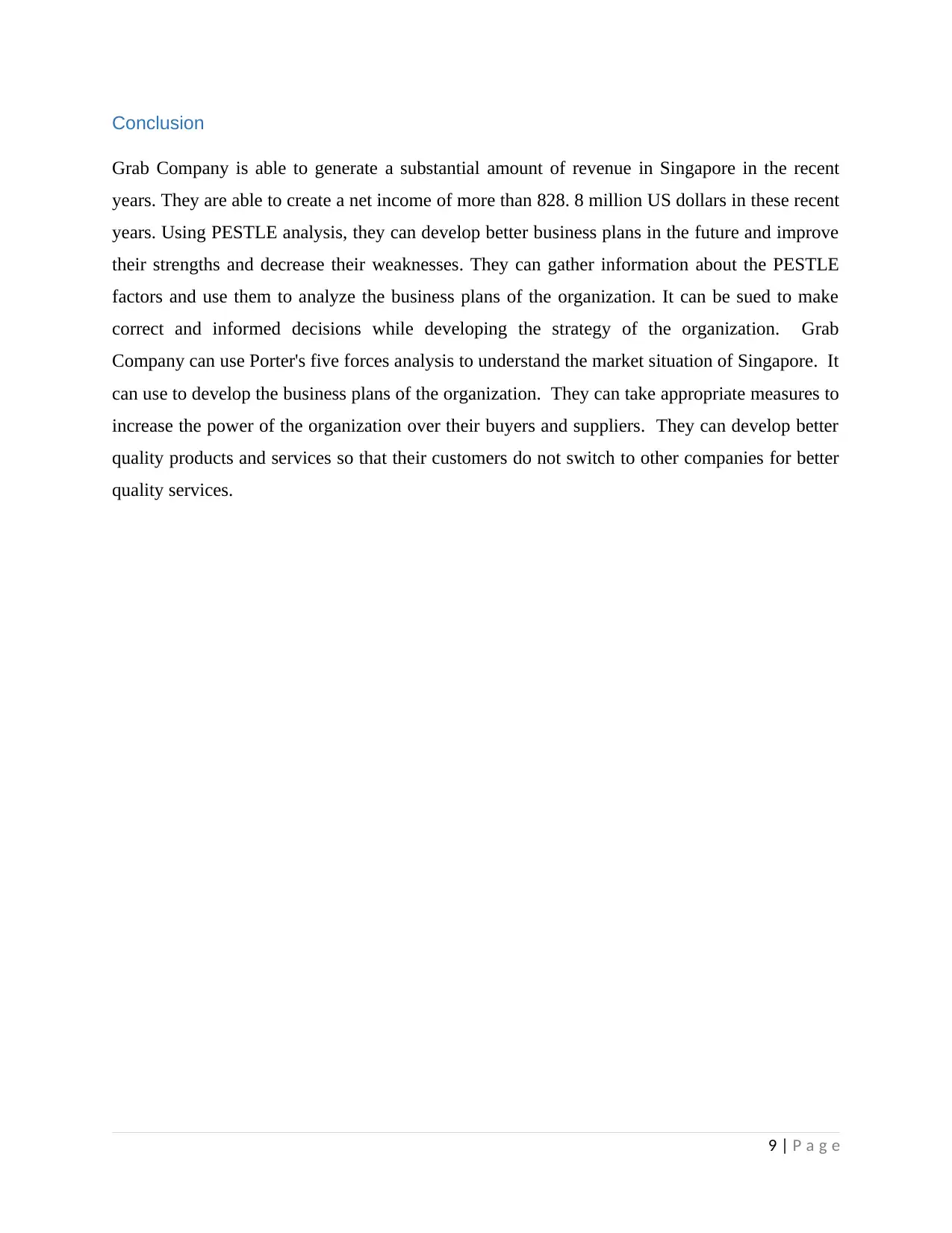
Conclusion
Grab Company is able to generate a substantial amount of revenue in Singapore in the recent
years. They are able to create a net income of more than 828. 8 million US dollars in these recent
years. Using PESTLE analysis, they can develop better business plans in the future and improve
their strengths and decrease their weaknesses. They can gather information about the PESTLE
factors and use them to analyze the business plans of the organization. It can be sued to make
correct and informed decisions while developing the strategy of the organization. Grab
Company can use Porter's five forces analysis to understand the market situation of Singapore. It
can use to develop the business plans of the organization. They can take appropriate measures to
increase the power of the organization over their buyers and suppliers. They can develop better
quality products and services so that their customers do not switch to other companies for better
quality services.
9 | P a g e
Grab Company is able to generate a substantial amount of revenue in Singapore in the recent
years. They are able to create a net income of more than 828. 8 million US dollars in these recent
years. Using PESTLE analysis, they can develop better business plans in the future and improve
their strengths and decrease their weaknesses. They can gather information about the PESTLE
factors and use them to analyze the business plans of the organization. It can be sued to make
correct and informed decisions while developing the strategy of the organization. Grab
Company can use Porter's five forces analysis to understand the market situation of Singapore. It
can use to develop the business plans of the organization. They can take appropriate measures to
increase the power of the organization over their buyers and suppliers. They can develop better
quality products and services so that their customers do not switch to other companies for better
quality services.
9 | P a g e
Paraphrase This Document
Need a fresh take? Get an instant paraphrase of this document with our AI Paraphraser
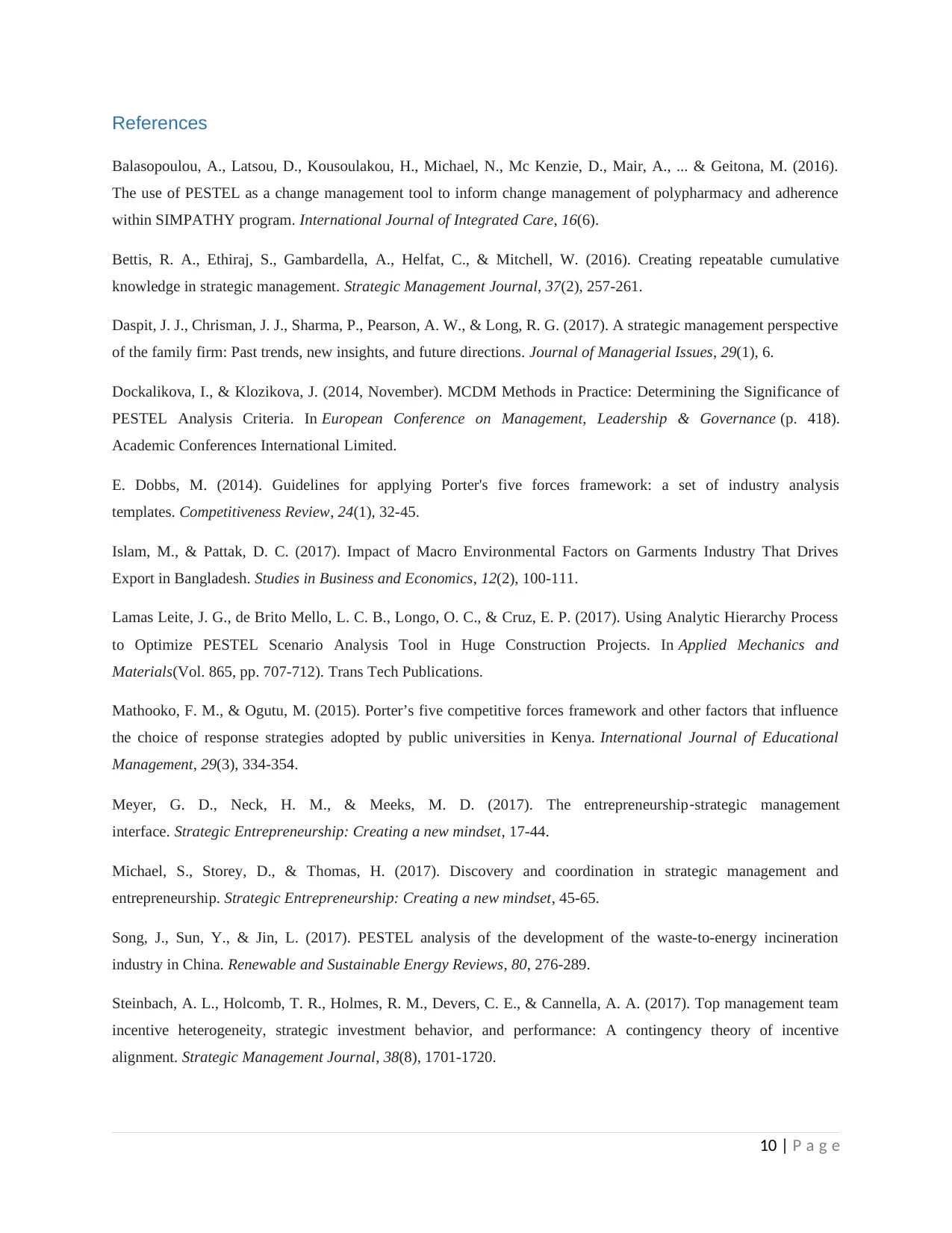
References
Balasopoulou, A., Latsou, D., Kousoulakou, H., Michael, N., Mc Kenzie, D., Mair, A., ... & Geitona, M. (2016).
The use of PESTEL as a change management tool to inform change management of polypharmacy and adherence
within SIMPATHY program. International Journal of Integrated Care, 16(6).
Bettis, R. A., Ethiraj, S., Gambardella, A., Helfat, C., & Mitchell, W. (2016). Creating repeatable cumulative
knowledge in strategic management. Strategic Management Journal, 37(2), 257-261.
Daspit, J. J., Chrisman, J. J., Sharma, P., Pearson, A. W., & Long, R. G. (2017). A strategic management perspective
of the family firm: Past trends, new insights, and future directions. Journal of Managerial Issues, 29(1), 6.
Dockalikova, I., & Klozikova, J. (2014, November). MCDM Methods in Practice: Determining the Significance of
PESTEL Analysis Criteria. In European Conference on Management, Leadership & Governance (p. 418).
Academic Conferences International Limited.
E. Dobbs, M. (2014). Guidelines for applying Porter's five forces framework: a set of industry analysis
templates. Competitiveness Review, 24(1), 32-45.
Islam, M., & Pattak, D. C. (2017). Impact of Macro Environmental Factors on Garments Industry That Drives
Export in Bangladesh. Studies in Business and Economics, 12(2), 100-111.
Lamas Leite, J. G., de Brito Mello, L. C. B., Longo, O. C., & Cruz, E. P. (2017). Using Analytic Hierarchy Process
to Optimize PESTEL Scenario Analysis Tool in Huge Construction Projects. In Applied Mechanics and
Materials(Vol. 865, pp. 707-712). Trans Tech Publications.
Mathooko, F. M., & Ogutu, M. (2015). Porter’s five competitive forces framework and other factors that influence
the choice of response strategies adopted by public universities in Kenya. International Journal of Educational
Management, 29(3), 334-354.
Meyer, G. D., Neck, H. M., & Meeks, M. D. (2017). The entrepreneurship‐strategic management
interface. Strategic Entrepreneurship: Creating a new mindset, 17-44.
Michael, S., Storey, D., & Thomas, H. (2017). Discovery and coordination in strategic management and
entrepreneurship. Strategic Entrepreneurship: Creating a new mindset, 45-65.
Song, J., Sun, Y., & Jin, L. (2017). PESTEL analysis of the development of the waste-to-energy incineration
industry in China. Renewable and Sustainable Energy Reviews, 80, 276-289.
Steinbach, A. L., Holcomb, T. R., Holmes, R. M., Devers, C. E., & Cannella, A. A. (2017). Top management team
incentive heterogeneity, strategic investment behavior, and performance: A contingency theory of incentive
alignment. Strategic Management Journal, 38(8), 1701-1720.
10 | P a g e
Balasopoulou, A., Latsou, D., Kousoulakou, H., Michael, N., Mc Kenzie, D., Mair, A., ... & Geitona, M. (2016).
The use of PESTEL as a change management tool to inform change management of polypharmacy and adherence
within SIMPATHY program. International Journal of Integrated Care, 16(6).
Bettis, R. A., Ethiraj, S., Gambardella, A., Helfat, C., & Mitchell, W. (2016). Creating repeatable cumulative
knowledge in strategic management. Strategic Management Journal, 37(2), 257-261.
Daspit, J. J., Chrisman, J. J., Sharma, P., Pearson, A. W., & Long, R. G. (2017). A strategic management perspective
of the family firm: Past trends, new insights, and future directions. Journal of Managerial Issues, 29(1), 6.
Dockalikova, I., & Klozikova, J. (2014, November). MCDM Methods in Practice: Determining the Significance of
PESTEL Analysis Criteria. In European Conference on Management, Leadership & Governance (p. 418).
Academic Conferences International Limited.
E. Dobbs, M. (2014). Guidelines for applying Porter's five forces framework: a set of industry analysis
templates. Competitiveness Review, 24(1), 32-45.
Islam, M., & Pattak, D. C. (2017). Impact of Macro Environmental Factors on Garments Industry That Drives
Export in Bangladesh. Studies in Business and Economics, 12(2), 100-111.
Lamas Leite, J. G., de Brito Mello, L. C. B., Longo, O. C., & Cruz, E. P. (2017). Using Analytic Hierarchy Process
to Optimize PESTEL Scenario Analysis Tool in Huge Construction Projects. In Applied Mechanics and
Materials(Vol. 865, pp. 707-712). Trans Tech Publications.
Mathooko, F. M., & Ogutu, M. (2015). Porter’s five competitive forces framework and other factors that influence
the choice of response strategies adopted by public universities in Kenya. International Journal of Educational
Management, 29(3), 334-354.
Meyer, G. D., Neck, H. M., & Meeks, M. D. (2017). The entrepreneurship‐strategic management
interface. Strategic Entrepreneurship: Creating a new mindset, 17-44.
Michael, S., Storey, D., & Thomas, H. (2017). Discovery and coordination in strategic management and
entrepreneurship. Strategic Entrepreneurship: Creating a new mindset, 45-65.
Song, J., Sun, Y., & Jin, L. (2017). PESTEL analysis of the development of the waste-to-energy incineration
industry in China. Renewable and Sustainable Energy Reviews, 80, 276-289.
Steinbach, A. L., Holcomb, T. R., Holmes, R. M., Devers, C. E., & Cannella, A. A. (2017). Top management team
incentive heterogeneity, strategic investment behavior, and performance: A contingency theory of incentive
alignment. Strategic Management Journal, 38(8), 1701-1720.
10 | P a g e
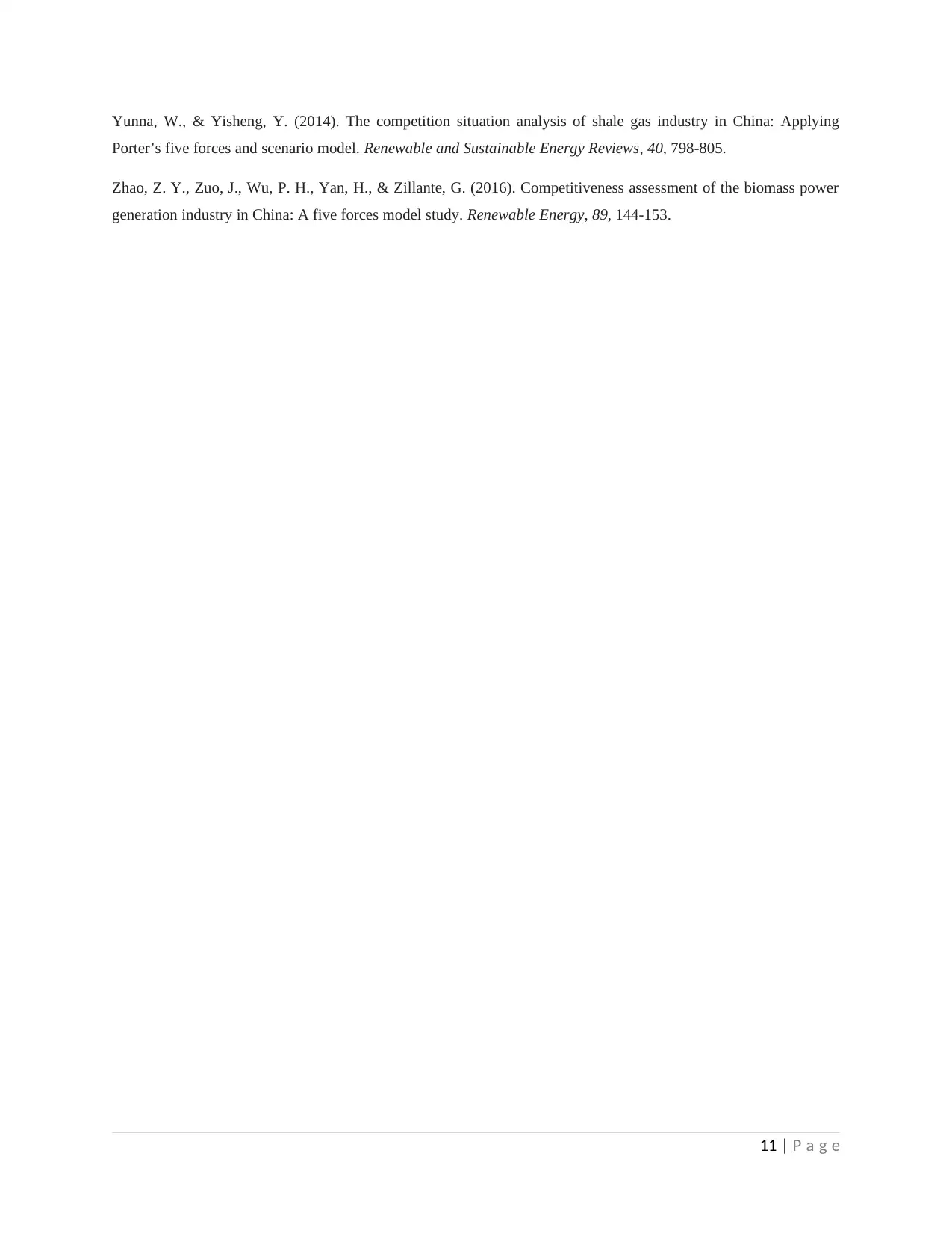
Yunna, W., & Yisheng, Y. (2014). The competition situation analysis of shale gas industry in China: Applying
Porter’s five forces and scenario model. Renewable and Sustainable Energy Reviews, 40, 798-805.
Zhao, Z. Y., Zuo, J., Wu, P. H., Yan, H., & Zillante, G. (2016). Competitiveness assessment of the biomass power
generation industry in China: A five forces model study. Renewable Energy, 89, 144-153.
11 | P a g e
Porter’s five forces and scenario model. Renewable and Sustainable Energy Reviews, 40, 798-805.
Zhao, Z. Y., Zuo, J., Wu, P. H., Yan, H., & Zillante, G. (2016). Competitiveness assessment of the biomass power
generation industry in China: A five forces model study. Renewable Energy, 89, 144-153.
11 | P a g e
⊘ This is a preview!⊘
Do you want full access?
Subscribe today to unlock all pages.

Trusted by 1+ million students worldwide
1 out of 12
Related Documents
Your All-in-One AI-Powered Toolkit for Academic Success.
+13062052269
info@desklib.com
Available 24*7 on WhatsApp / Email
![[object Object]](/_next/static/media/star-bottom.7253800d.svg)
Unlock your academic potential
Copyright © 2020–2025 A2Z Services. All Rights Reserved. Developed and managed by ZUCOL.




